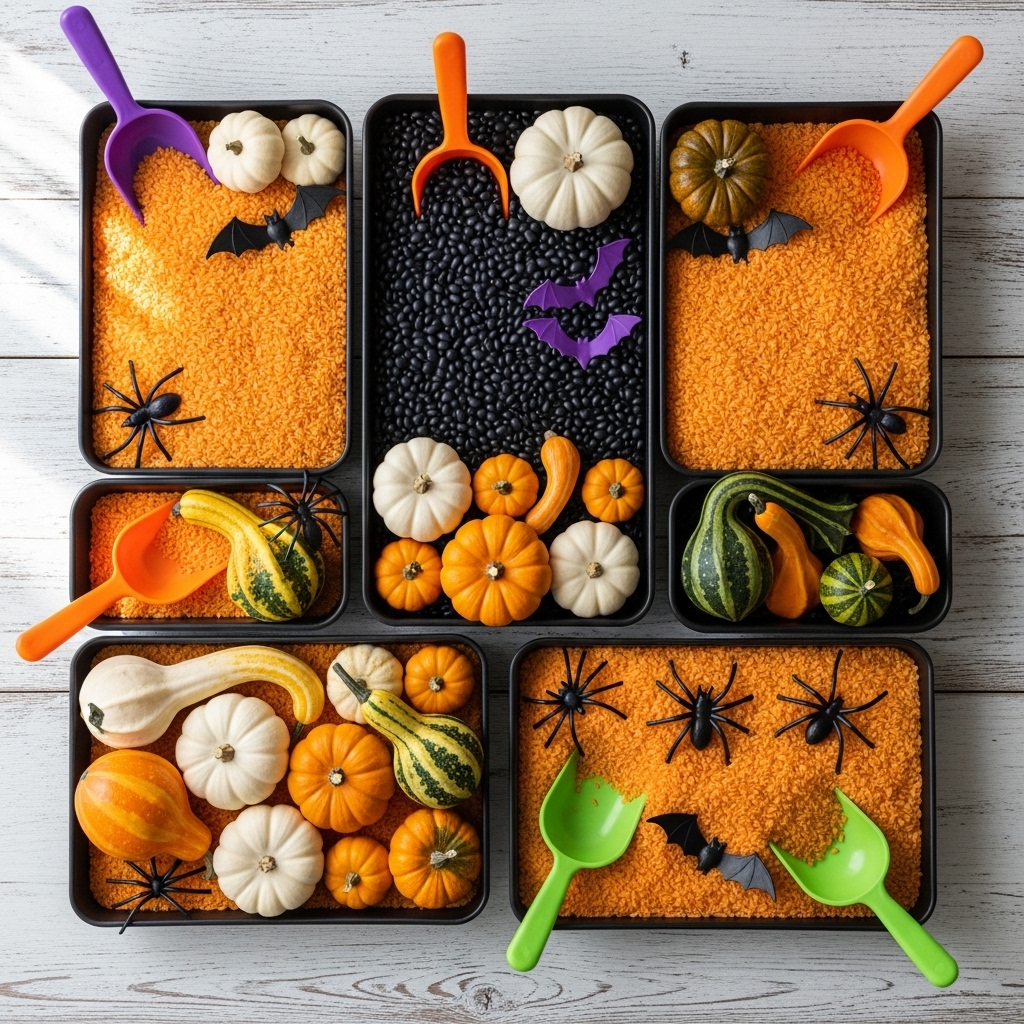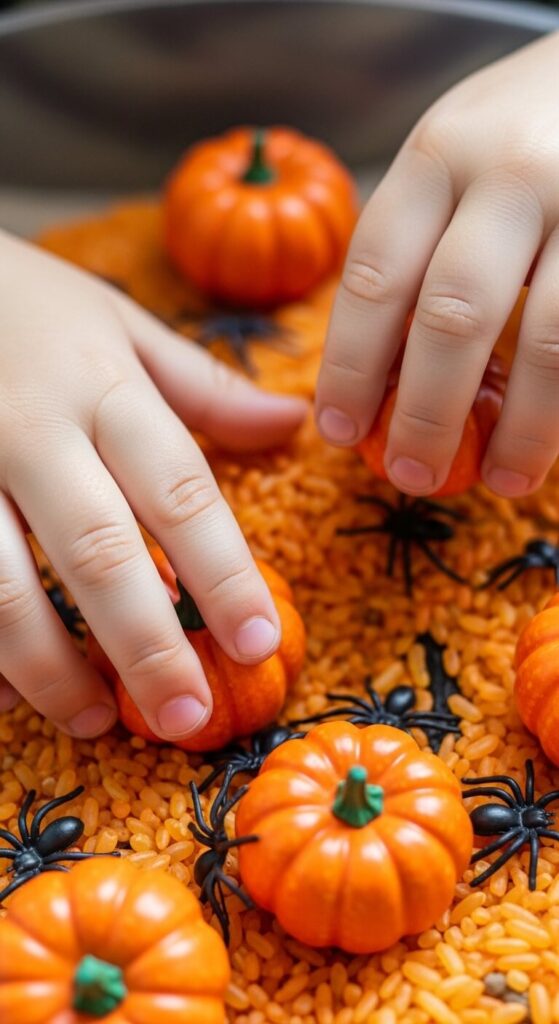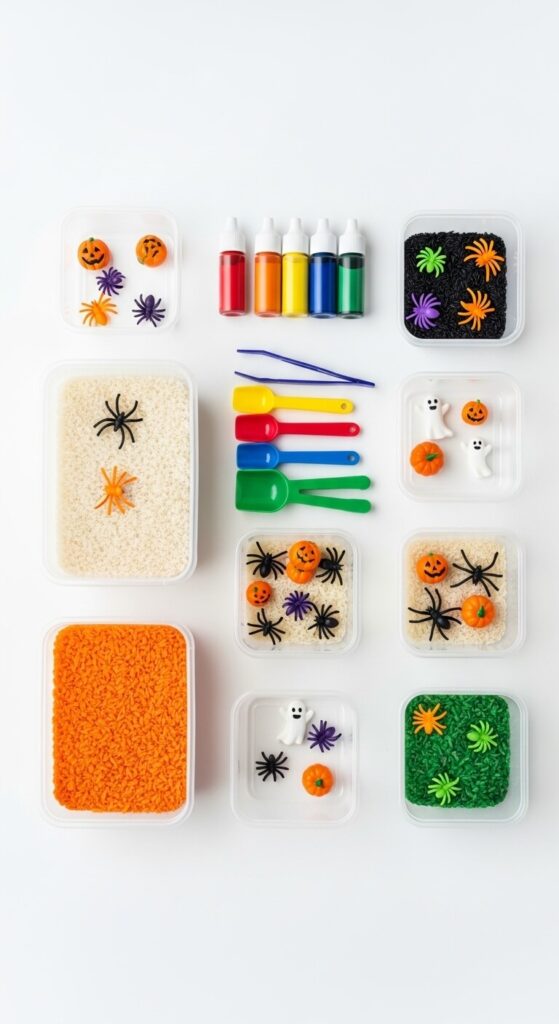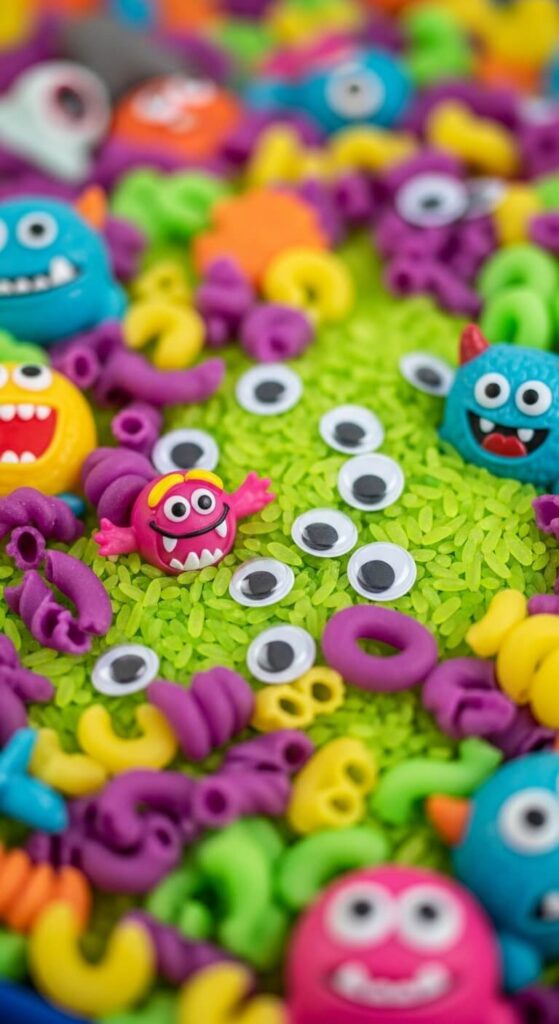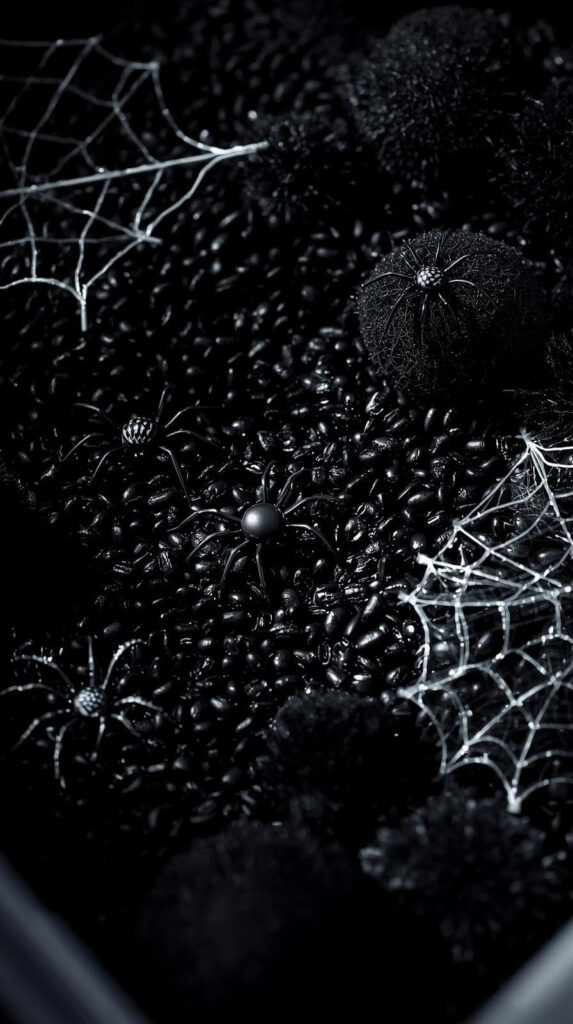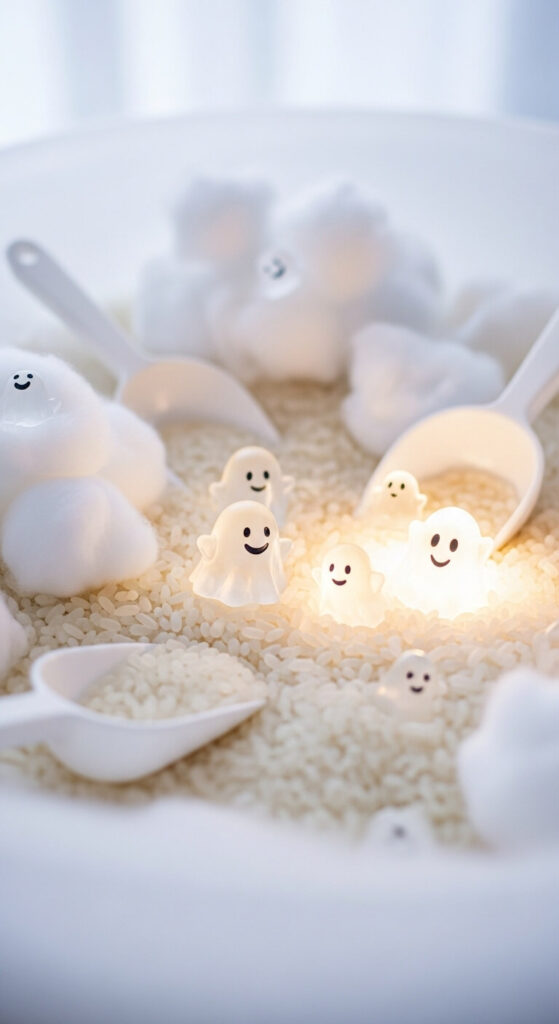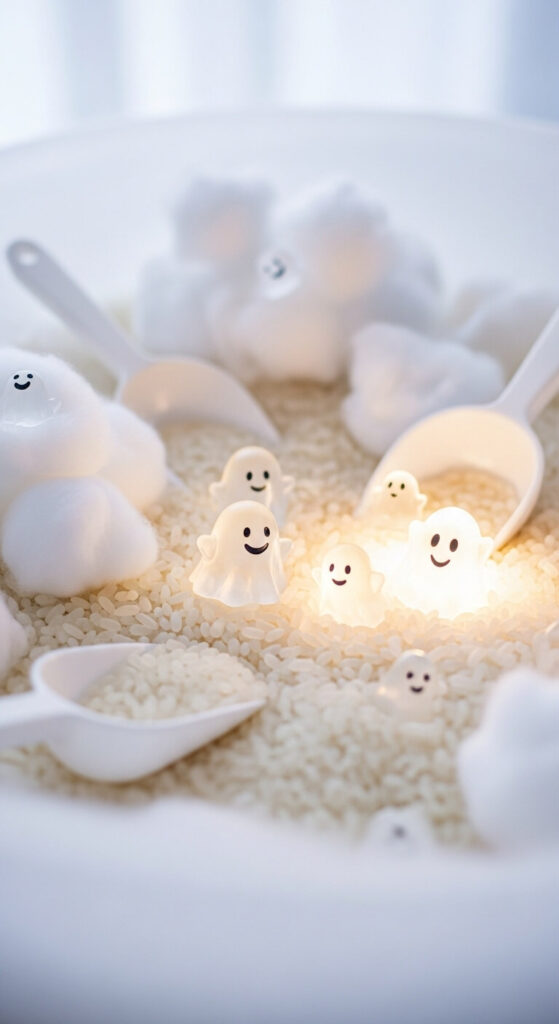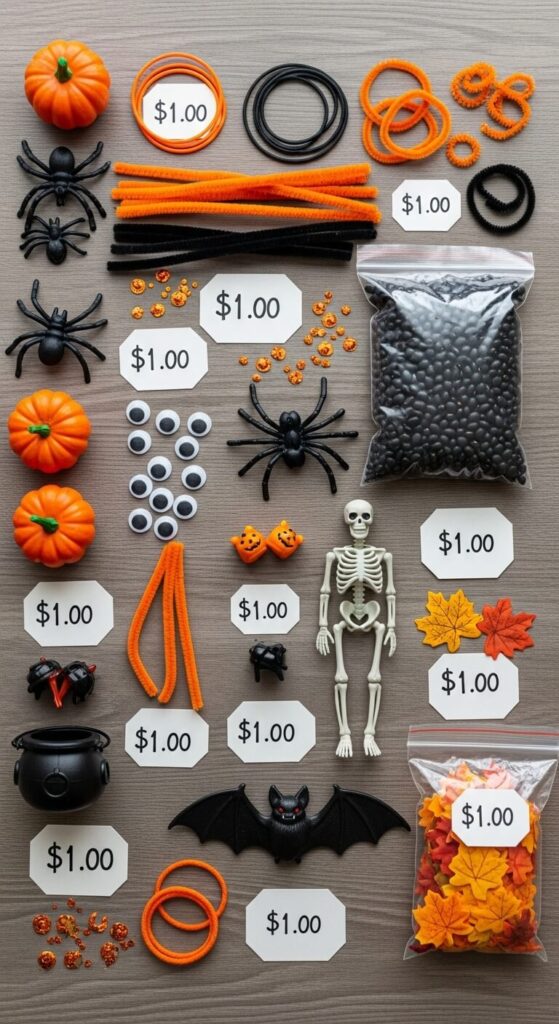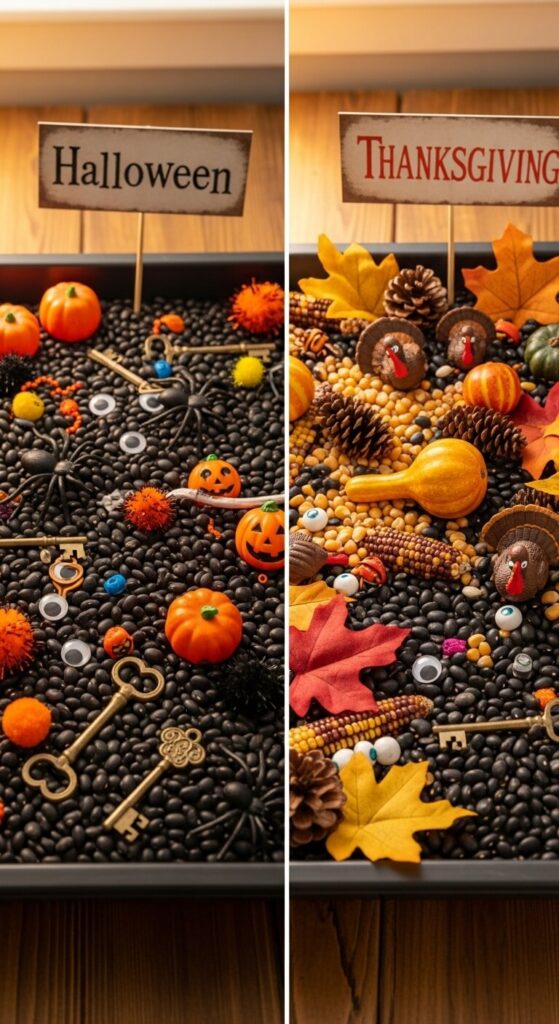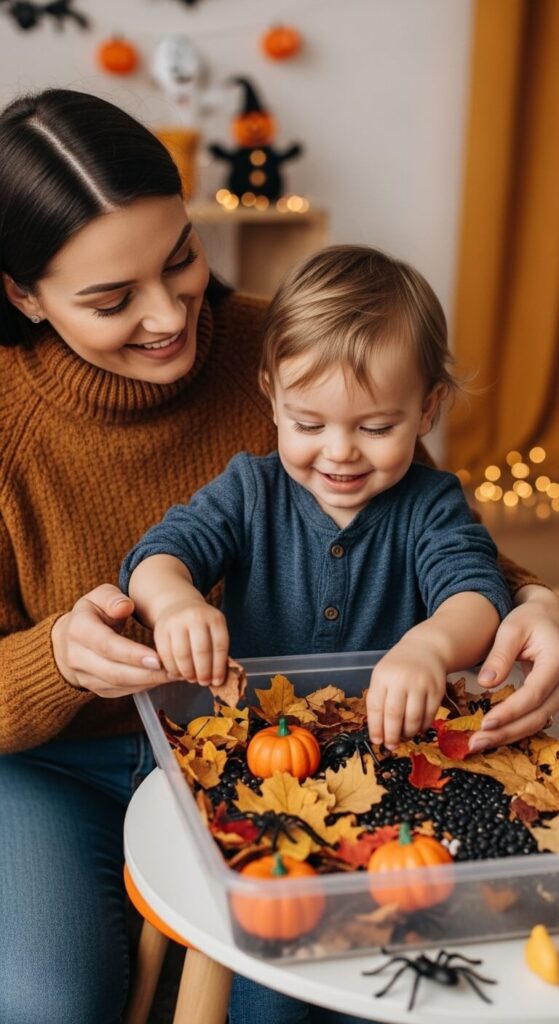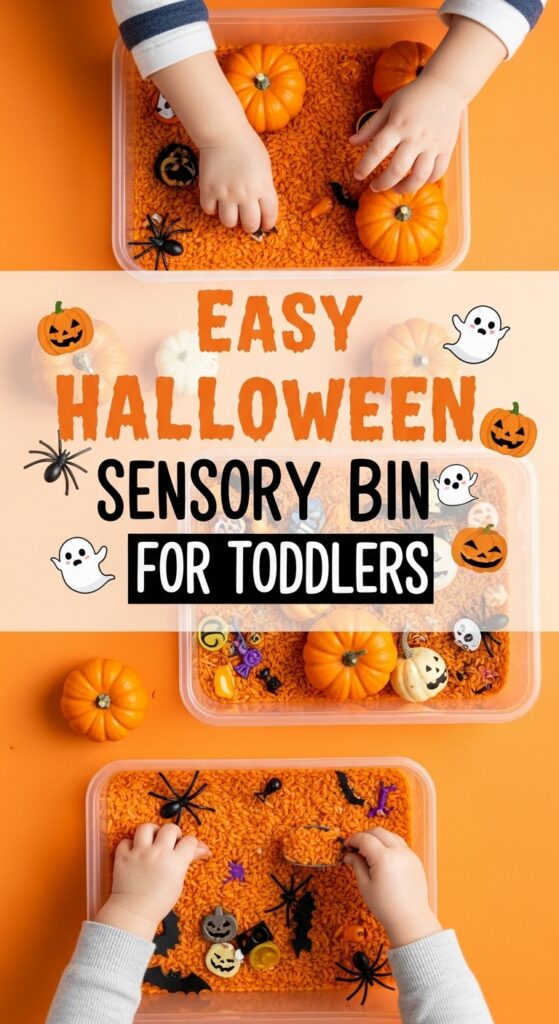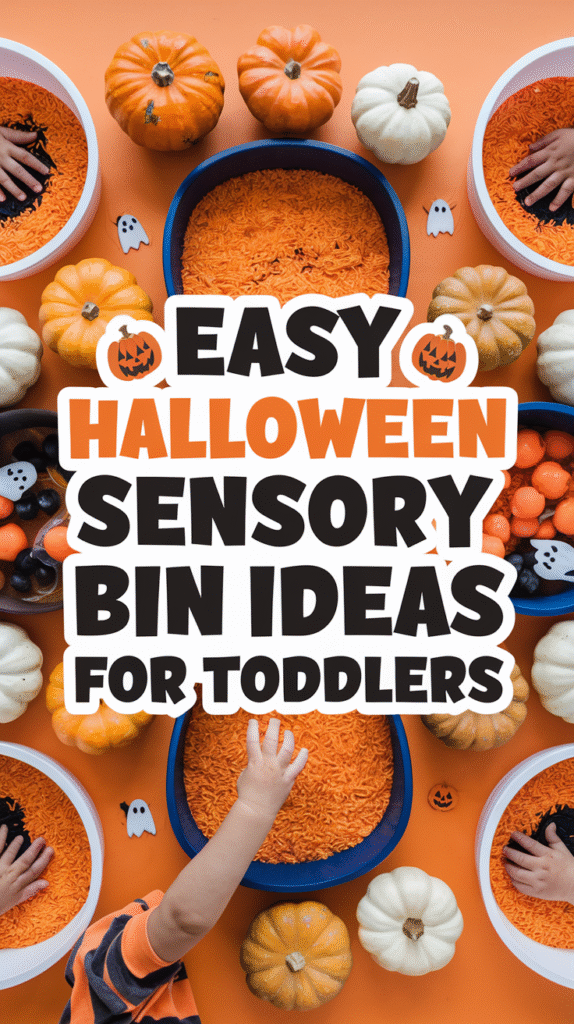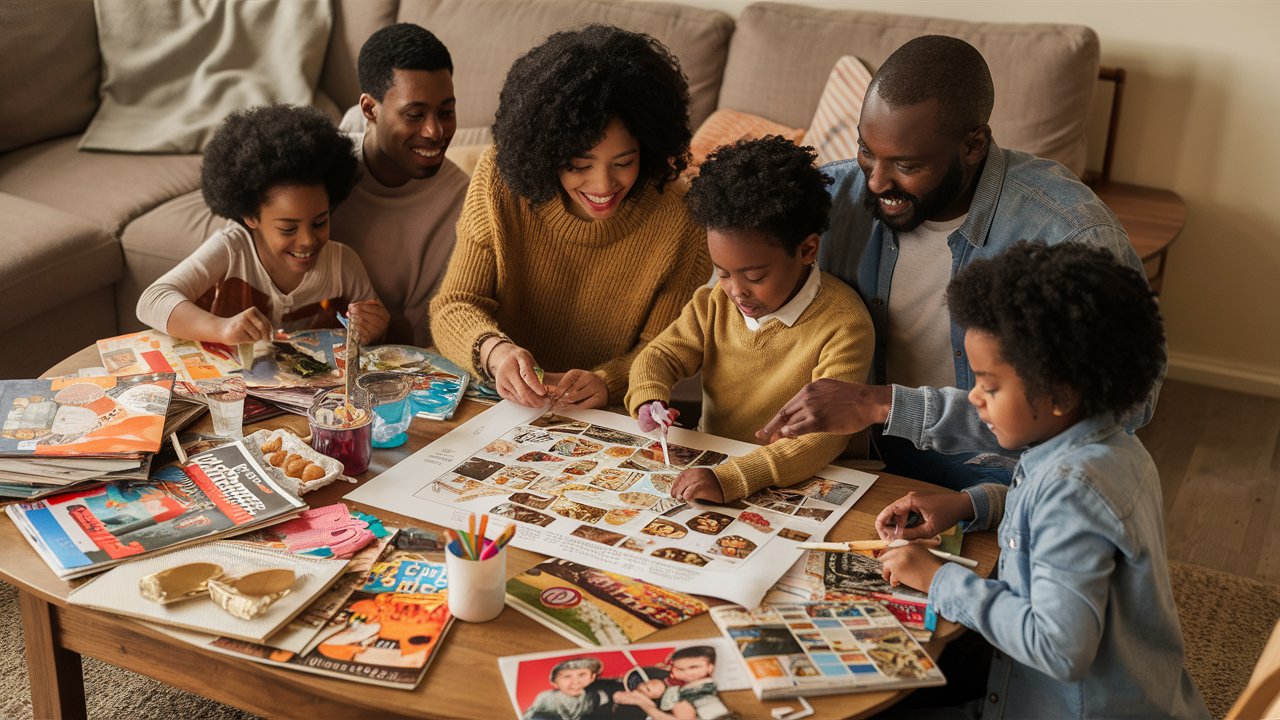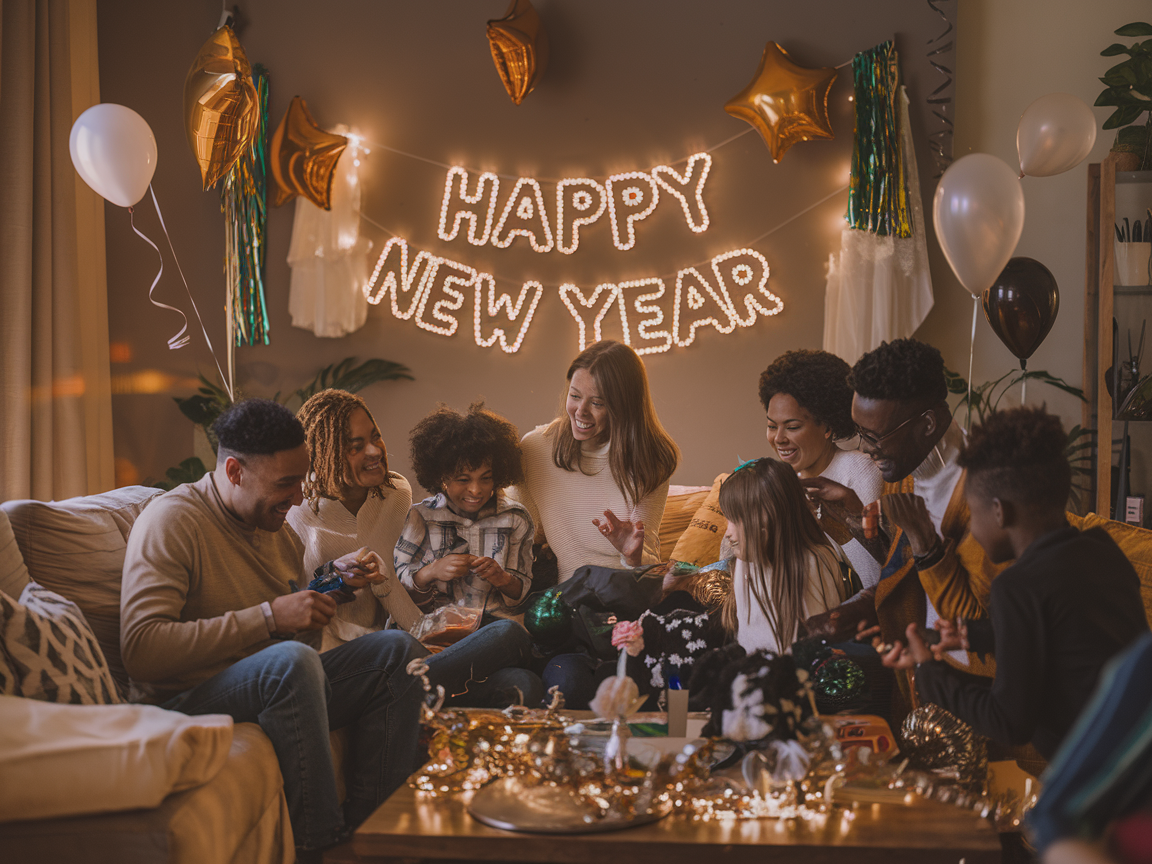Let’s be real – Halloween with toddlers can feel like you’re juggling flaming pumpkins while wearing a blindfold. You want to create magical memories, but you also don’t want to spend your entire paycheck or clean up glitter from every surface until Christmas. That’s where Halloween sensory bins come to the rescue! These little containers of organized chaos keep tiny hands busy, brains engaged, and (fingers crossed) messes contained.
I’ve been creating sensory bins for years, and honestly? Halloween ones are my absolute favorite. There’s something about combining spooky fun with educational play that just works. Plus, your toddler gets to explore textures, practice fine motor skills, and burn off some of that endless energy – all while you sip your coffee and pretend you have everything under control 🙂
What Makes Halloween Sensory Bins So Special?
Halloween sensory bins aren’t just regular play bins with orange plastic pumpkins thrown in. They’re carefully crafted experiences that combine seasonal themes with developmental benefits. Think of them as your toddler’s personal haunted house – but instead of jump scares, they get sensory exploration and learning opportunities.
The beauty of Halloween sensory bins lies in their versatility. You can create spooky scenes, focus on colors and textures, or even sneak in some early math concepts. Ever wondered why toddlers become obsessed with certain activities? It’s because they’re getting exactly what their developing brains crave – hands-on exploration that engages multiple senses simultaneously.
What I love most about these bins is how they grow with your child. A simple Halloween-themed rice bin can entertain a 12-month-old who’s just discovering cause and effect, while a more complex setup with hidden treasures and sorting activities challenges a 3-year-old’s problem-solving skills.
Essential Supplies for Halloween Sensory Bins
Before we jump into the fun stuff, let’s talk about what you actually need. FYI, you probably already have most of these items lying around your house – no need to make a special trip to the craft store (though let’s be honest, we all love an excuse to browse the Halloween aisle).
Base Materials
- Large plastic containers or storage bins – Clear ones work best so kids can see what’s inside
- Rice, pasta, or dried beans as your foundation (colored or natural)
- Orange and black food coloring for that classic Halloween vibe
- Scoops, spoons, and small containers for transferring activities
Halloween-Themed Add-ins
- Mini pumpkins (real or plastic)
- Plastic spiders (check that they’re toddler-safe sizes)
- Halloween erasers from the dollar store
- Orange and black pom-poms
- Foam stickers in Halloween shapes
- Small toy skeletons or Halloween figurines
Tools and Accessories
- Tweezers or tongs for fine motor practice
- Small bowls for sorting activities
- Magnifying glasses (because everything’s more exciting when it’s bigger!)
- Halloween-themed ice cube trays for sorting
Trust me, once you start collecting sensory bin supplies, you’ll become that parent who gets genuinely excited about finding the perfect tiny Halloween decorations at the grocery store checkout.
Pumpkin Patch Paradise Bin
This bin is pure autumn magic in a container. I start with orange-dyed rice as the base – it looks like a miniature pumpkin patch and feels amazing to run little fingers through. The key is getting the rice color just right; you want that warm pumpkin orange, not traffic cone orange.
To create this masterpiece, fill your container about halfway with the orange rice. Add various sizes of mini pumpkins – both real and plastic work great. Throw in some artificial autumn leaves, small scoops, and tiny baskets for harvesting. The goal is to recreate that classic pumpkin patch experience on a toddler-friendly scale.
Activities to Try:
- Pumpkin counting (start with 1-5 for younger toddlers)
- Size sorting using different pumpkin sizes
- “Harvesting” pumpkins into baskets
- Texture exploration comparing smooth pumpkins to bumpy rice
What makes this bin special is how it connects to real-world experiences. If you’ve taken your toddler to an actual pumpkin patch, they’ll love recreating that adventure at home. And if you haven’t made it to a pumpkin patch yet, this gives them a taste of what’s coming!
The sensory benefits here are incredible. The rice provides tactile stimulation, the pumpkins offer different weights and textures, and the scooping activities strengthen those crucial hand muscles needed for writing later on.
Spooky Spider Sensory Adventure
Okay, I know what you’re thinking – spiders and toddlers don’t exactly sound like a match made in heaven. But hear me out! This bin is actually one of my most successful Halloween setups, and it’s helped several kids I know overcome their spider fears through gentle, controlled exposure.
Start with black beans or black rice as your base. The dark color creates that mysterious, cave-like atmosphere that’s perfect for our eight-legged friends. Add plastic spiders in various sizes (make sure they’re large enough to avoid choking hazards), some black pom-poms for spider eggs, and artificial spider webs stretched across parts of the bin.
Spider-Themed Activities:
- Spider counting and sorting by size or color
- Web rescue missions using tweezers to “save” trapped items
- Creating spider families and making up stories
- Fine motor practice moving spiders with tongs
The psychological benefits of this bin are pretty amazing. By giving toddlers control over the spiders – they can pick them up, move them around, and even make them “dance” – you’re helping them feel empowered rather than scared. It’s exposure therapy disguised as play!
Pro tip: Start with just one or two spiders if your toddler seems hesitant, then gradually add more as they become comfortable. You’ll be surprised how quickly fear transforms into fascination when they’re in control.
Ghostly White Wonderland
Sometimes the most effective bins are the simplest ones. This all-white sensory bin creates an ethereal, ghostly atmosphere that’s both calming and intriguing. I use white rice, white beans, or even cloud dough as the base, then add white pom-poms, cotton balls, small ghost figurines, and white scoops.
The monochromatic approach might seem limiting, but it actually enhances focus and allows toddlers to concentrate on textures and shapes rather than being overwhelmed by multiple colors. It’s like creating a winter wonderland in October!
Ghostly Activities:
- Texture comparison between different white materials
- Hide and seek with ghost figures
- Cloud dough molding (if using that base)
- Peaceful scooping and pouring activities
This bin works especially well for highly sensitive toddlers who might find traditional Halloween decorations overwhelming. The soft white theme maintains the seasonal connection without being too intense or scary.
Candy Corn Counting Celebration
Let’s face it – toddlers are naturally drawn to anything that looks like candy. This bin capitalizes on that attraction while sneaking in some serious learning opportunities. I use tri-colored rice (white, orange, and yellow) layered to look like giant candy corn, plus actual candy corn erasers and toys for added excitement.
The layered rice creates a beautiful visual effect, and watching toddlers discover the different colored layers as they dig is pure joy. Add small cups for sorting, spoons for scooping, and maybe some Halloween-themed ice cube trays for creating perfect candy corn patterns.
Educational Opportunities:
- Color recognition and sorting
- Pattern practice with candy corn arrangements
- Counting activities using candy corn pieces
- Layering concepts as they redistribute the rice
This bin seamlessly combines math concepts with sensory play. You can work on one-to-one correspondence, basic addition (adding candy corn pieces together), and even early patterning skills. IMO, it’s one of the most educationally rich bins you can create.
Monster Mash Mayhem Bin
Here’s where we let loose and embrace the silly side of Halloween! This bin is all about colorful chaos – think neon green rice mixed with purple pasta, googly eyes scattered everywhere, and the most ridiculous monster toys you can find.
I love including different textures in this bin: smooth monster balls, bumpy sensory balls, soft fabric scraps in monster colors, and plenty of googly eyes in various sizes. The goal is controlled mayhem that sparks creativity and imaginative play.
Monster Activities:
- Creating monster faces using googly eyes and materials
- Monster voice practice (great for language development)
- Color mixing experiments if using play dough elements
- Storytelling with the monster characters
This bin encourages dramatic play and creativity in ways that more structured activities can’t. Toddlers can create their own monster stories, practice different voices, and explore cause-and-effect relationships through monster interactions.
The best part? There are no rules here. If your toddler wants to make a purple monster with seventeen eyes who lives in a pasta cave, that’s absolutely perfect!
Safety First: Halloween Sensory Bin Guidelines
Before we get too carried away with our spooky creations, let’s talk safety. Because nothing ruins Halloween fun like a trip to the emergency room, right?
Size Matters
Always choose items that are larger than your toddler’s mouth. The general rule is that if it fits through a toilet paper tube, it’s too small for unsupervised play. This is especially important with small Halloween decorations that seem perfectly sized for little hands.
Material Safety
- Avoid items with sharp edges or points
- Check that food coloring is washable and non-toxic
- Ensure all plastic items are BPA-free when possible
- Test any new materials on a small area first
Supervision Guidelines
Even the safest sensory bin requires active supervision. Stay within arm’s reach, especially during those initial explorations when toddlers are most likely to test whether Halloween erasers are actually edible 🙂
Clean-Up Considerations
Choose materials that are easy to vacuum or sweep up. Trust me, orange rice scattered across your living room loses its charm pretty quickly when you’re finding it in random corners weeks later.
Storage and Maintenance Tips
One thing I learned the hard way is that proper storage makes or breaks your sensory bin success. You can create the most amazing Halloween wonderland, but if it gets moldy or infested with bugs, it’s game over.
Container Selection
Invest in airtight containers with secure lids. Clear storage bins work best because you can see what’s inside, and toddlers love being able to preview their upcoming sensory adventure.
Rice and Base Material Care
If you’re using natural materials like rice or beans, make sure they’re completely dry before storage. I add a few rice packets (you know, the ones that come in shoe boxes) to absorb any excess moisture.
Rotating Themes
Don’t feel like you need to keep all your Halloween bins out simultaneously. Rotate them throughout October to maintain novelty and excitement. Store off-season bins in a cool, dry place, and always check for any signs of pest activity before reintroducing them.
Seasonal Transition
After Halloween, many of these materials can transition into Thanksgiving or fall-themed bins. Orange rice becomes harvest corn, pumpkins become autumn decorations, and spiders… well, maybe the spiders can hibernate until next year!
Budget-Friendly Halloween Sensory Solutions
Let’s be honest – Pinterest can make you feel like you need to spend a fortune to create Instagram-worthy sensory bins. But some of my most successful bins have been created with dollar store finds and household items.
Dollar Store Treasures
- Halloween erasers and small toys
- Plastic containers and scoops
- Food coloring for rice dyeing
- Small figurines and decorations
Household Item Repurposing
- Empty yogurt containers become perfect scooping tools
- Ice cube trays are ideal for sorting activities
- Muffin tins create individual sensory stations
- Mason jars are perfect for storing colored rice
DIY Alternatives
Instead of buying expensive sensory bin fillers, try making your own cloud dough (flour and oil), jello sensory bases, or water bead alternatives using tapioca pearls.
The truth is, toddlers care more about the experience than expensive materials. Some of my most memorable sensory bin moments have happened with the simplest setups.
Extending the Halloween Fun Beyond October
Who says Halloween sensory bins are only for October? These activities can easily transition into year-round learning opportunities with small modifications.
Your pumpkin patch bin becomes a harvest celebration bin. The spider bin transforms into a general bug exploration station. And that candy corn counting bin? Perfect for practicing math concepts any time of year!
Integration Ideas
- Connect sensory bin themes to books you’re reading
- Use bins to support cheap Halloween party games for kids that don’t require screens
- Combine with pumpkin decorating without knives activities for complete themed days
- Document your toddler’s creations and discoveries
Educational Extensions
Use these bins as launching points for deeper learning. That spider bin can lead to nature walks looking for real spider webs. The pumpkin patch bin connects to grocery store visits and cooking activities.
The key is following your toddler’s interests and building on their natural curiosity.
Final Thoughts: Making Halloween Memories That Matter
Creating Halloween sensory bins isn’t just about keeping toddlers busy (though let’s be real, that’s definitely a perk). It’s about providing rich, multi-sensory experiences that support their development while building positive associations with seasonal celebrations.
I’ve watched countless toddlers transform from cautious observers to confident explorers through sensory bin play. There’s something magical about watching a child’s face light up when they discover a hidden treasure or successfully complete a challenging transfer task.
The best part? These memories stick. Years later, kids remember the bins where they first learned to count, overcame fears, or simply spent peaceful moments exploring and discovering.
So grab that storage container, raid your Halloween decorations, and create some sensory magic. Your toddler’s developing brain (and your sanity) will thank you. And remember – there’s no such thing as a perfect sensory bin. The best one is simply the one your child enjoys exploring.
Happy Halloween, and may your sensory bins be ever engaging and your clean-up minimal! 🎃

